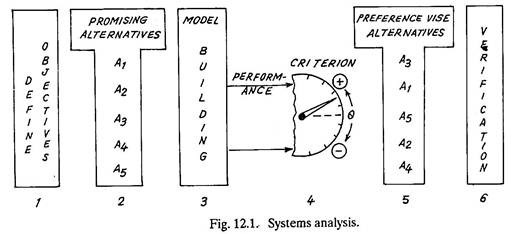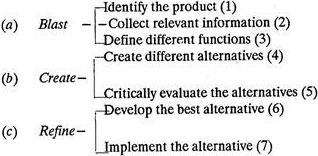After reading this article you will learn about systems concept and value analysis.
Systems Concept:
The society and the industry is more complex today than it was ever before. More and more persons are acquiring higher education and technical skills, newer materials and information’s are being rigged up and under such situations, rules of thumb cannot be highly relied upon.
Systems concept gives to industry and to other large business organisations, a systematic approach to get the task accomplished more efficiently, effectively and economically. Systems approach is an organised approach for complex (Military and Industrial) equipment design and the same can be completed in a much shorter duration with comparatively less efforts.
Systems concept furnishes a frame of references which tells how to manage the jobs or how to analyse complex phenomena under different environments.
ADVERTISEMENTS:
Systems approach is more common in the field of physical sciences and engineering because it is comparatively easier to build a model of such systems. However, the systems approach can also be used to solve problems related to business or human values (like fire protection, housing, etc.).
Systems Engineering differs from Industrial Engineering in the sense that industrial engineering sub- sciences like work study, production planning and (quality) control, etc., take interest in both physical and non-physical systems whereas systems engineering is primarily concerned with Information Systems (or non-physical systems). Secondly, the different sub-sciences or industrial engineering came out as a result of the development of industries whereas systems engineering coined out of the information models which controlled the industries, industrial operations and organisation.
System:
A system may be defined as a collection of interacting elements that operate to achieve a predetermined objective. In simple terms, a system may be visualized as a processing unit which receives certain inputs and is urged to act upon them in some desirable fashion to produce outputs with a purpose to optimize some function of input and output. Inputs may be in the form of energy, matter, information, etc. Processing unit may be activated and controlled by men or machines. The output may be in the form of products, services or information and the objective may be to maximize output.
ADVERTISEMENTS:
A system is dynamic in nature. A system may have animate or inanimate interacting elements. A thunder storm is an inanimate system whereas a hospital (building) together with its staff and operating conditions is an animate system. In this system, the input is medicines, medical instruments, patients, etc.; the processing unit includes doctors, other staff and machinery; the output is the relief to the patients and the objective is to treat satisfactorily as many patients as possible in a given time.
A few examples of other systems are as under:
(a) A human body is a system with various sub-systems like nervous, blood circulation, breathing, eating and drinking, etc.
(b) An industry is a system with various subsystems like purchase, production, sales, etc.
ADVERTISEMENTS:
(c) A transportation system. It has its subsystems like road, rail, air and marine transportation.
Classification of Systems:
A system may be:
(i) Mechanistic:
ADVERTISEMENTS:
A mechanistic system is one which though is fully mechanised yet the choice of system composition remains in the hands of human beings. The examples of the mechanistic systems are, dial telephone, guided missiles, space rockets, etc.
(ii) Quasi-Mechanistic:
In a quasi-mechanistic system human beings carry out some of the mechanical functions. A fighter plane is a quasi-mechanistic system.
(iii) In another type of system, human elements act in a non-mechanical manner, take decisions and improve the system. Production system is an example of this kind of system.
Systems Analysis:
ADVERTISEMENTS:
Systems analysis involves the Study and Construction of Systems. Systems analysis is the study of each part of the system, both as an individual and in relation to the whole in order to design, modify or improve the system; it is immaterial whether it is an abstract system like inventory control procedure or it is a physical system such as power transmission in a vehicle.
Procedure:
Systems analysis involves a continuous cycle of the following:
ADVERTISEMENTS:
(1) Define Objectives:
It is the conceptual phase in which the objectives are clarified and defined with a view to select a policy regarding action or decision-making for solving the problem.
(2) Promising Alternatives:
ADVERTISEMENTS:
Promising alternative programmes, which can possibly achieve the objectives, are thought of and designed.
(3) Model Building:
Promising alternative programmes can be shaped into models. A Model is an analog of reality. It represents the system qualitatively or quantitatively. A model may be in the physical form or it may be a mathematical presentation of the system. It is always cheaper and convenient to forecast the consequences and to test the performance of a system from its model rather getting the same information after going through the complicated process of actually fabricating the system being considered. Depending upon the type of problem, there can be an overall process model, performance model, reliability model, time model or cost model.
(4) Criterion:
The individual models are evaluated in terms of the criterion specified before. The criterion may be effectiveness, cost, performance or cost against performance, etc.
(5) Preference-Wise Alternatives:
ADVERTISEMENTS:
From the performance of models, various alternative programmes are listed in order of preference.
(6) Verification:
The most promising alternative/alternatives are tested by experiments and their good points are verified.
Systems Engineering:
Systems engineering involves the Analysis and Synthesis of systems. The systems engineering includes the following three major steps for designing complex and highly engineered Military and Industrial equipment systems.
(a) Define the Problem:
Specify the input-output requirements of the system.
ADVERTISEMENTS:
(b) Solve the Problem:
Select and define the sub-systems; write system, sub-system and sub-system interface specifications; and find out the performance of the system.
(c) Check the Solution:
Check the solution to ascertain if the designed equipment system fulfills the requirements expected of it.
Applications of Systems Engineering:
Systems approach finds the following applications:
ADVERTISEMENTS:
(1) Design and development of complex, highly engineered Industrial equipment systems,
(2) Design and development of Military equipment and weapon systems,
(3) In the choice of tactical alternatives,
(4) Management of operations, and
(5) In deciding major policy alternatives.
Value Analysis/Engineering:
Value analysis developed as a cost reduction technique in U.S.A. in 1947. The credit for it goes to Lorry D. Miles who was working at G.E. and who, subsequently became the President of SAVE (Society of American Value Engineers) also. Value engineering got developed because of the inherent desire in the man to make cheaper and to sell cheaper; keeping the utility of the products, of course, same.
ADVERTISEMENTS:
Value Analysis discovers new tactical alternatives. It is a special type of cost reduction technique which unlike other (similar) methods does not blindly accept the product design. Rather, it critically investigates and analyses the different aspects of materials (purchase), design and production of each and every component of the product.
A component, to be a part of the product must perform some function and serve some purpose. Value analysis examines the design, function and cost of each and every component in order to produce it economically without decreasing its utility, function or reliability. Value analysis is normally applied to existing rather than to new products.
Aim of Value Analysis:
The aim of Value Analysis is to generate promising ideas, to:
(i) Simplify the product,
(ii) Use (new) cheaper and better materials,
ADVERTISEMENTS:
(iii) Modify and improve product design,
(iv) Use efficient processes,
(v) Reduce the product cost,
(vi) Increase the utility of the product by economical means, and
(vii) Save money or to increase the profits.
A Value Analysis Team consists of personnel from different sections such as R&D, purchase, material control, design, manufacture, inspection, marketing, finance, etc.
Value Analysis Technique:
A number of questions as framed by Miles at G.E. and others are given below. Each component part of the product is analysed in the light of these questions (or tests).
(i) Does it (i.e., component) contribute value to end product?
(ii) Is its cost proportionate to its function?
(iii) Can some of its features be combined or eliminated?
(iv) Would there be a better product?
(v) Can a component be produced by less costly process? For example G.E. (U.S. A) changed from die-cast cover to a stamping and saved S39,000 annually.
(vi) Can one go for an available standard product/component?
(vii) Taking into account the quantity required, is the product being made with proper tools?
(viii) Does the product have reasonable selling price?
(ix) Can the product/component be procured at less cost from elsewhere?
(x) Is anybody purchasing the product/component at lower rates.
Besides these questions, the detailed Value Analysis procedure is discussed as under:
Step-1:
The first step is to identify the Product for which Value Analysis is to be carried out. The product should be one which if redesigned can add to the sales income and would not become obsolete in near future. Value Analysis may be applied to the product as a whole or to only some of its component parts.
Step-2:
The information relevant to the product may be as follows:
(i) Technical specifications with drawings,
(ii) Manufacturing processes, machine layout and instruction sheets,
(iii) Time study details and manufacturing capacity,
(iv) Complete cost data and marketing details, and
(v) Latest developments in related products.
Step-3:
Identify the primary, secondary, and tertiary functions of the product. Specify value content of each function and identify the high cost areas.
Step-4:
Knowing the functions of each component part and its manufacturing details, generate the ideas and create different alternatives so as to increase the value of the product. The Value Analysis team can hold Brainstorming sessions. All suggestions feasible or non-feasible are recorded without any criticism; rather, persons are encouraged to express their views freely.
Step-5:
The different ideas recorded under step-4 are compared, evaluated and critically assessed for their virtues, validity and feasibility as regards their financial and technical requirements. Ideas technically sound and involving lower costs are further developed.
Step-6:
Detailed development plans are made for those ideas which, during step-5, appear most suitable and promising. Development plans comprise of, drawing the sketches, building of models, and conducting discussions with the purchase section, finance section, marketing division, etc.
Step-7:
The best found idea under step-6 is converted into a prototype manufacture which ultimately goes into operation and its results are recorded. The product cost and functional analysis is carried out to assess the net saving as the result of Value Analysis.
Advantages:
1. Value Analysis is a much faster cost reduction technique.
2. It requires little expenditure because the Value Analysis team can be formulated out of the staff available in different sections like purchase, production, finance, etc.
3. Value analysis reduces production costs and adds to sales income of the product.
Applications:
A few applications of Value Analysis/Value Engineering are listed below:
1. Military equipment (T-55 tanks and many other equipment).
2. Import substitutes.
3. Machine tool industry.
4. Industries making material handling equipment.
5. Auto industries, etc.
Value Engineering:
Value Engineering is the application of the concepts of value analysis at the design or pre-manufacture stage of the component parts with a view to cut down the unnecessary costs, without impairing the function or utility of the product.
Value Control:
Value Control means controlling the value of a product; either by reducing its cost for the given function or by increasing its utility for the given cost.

